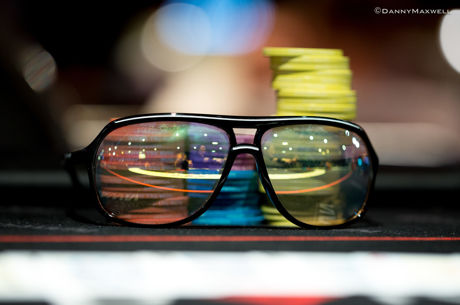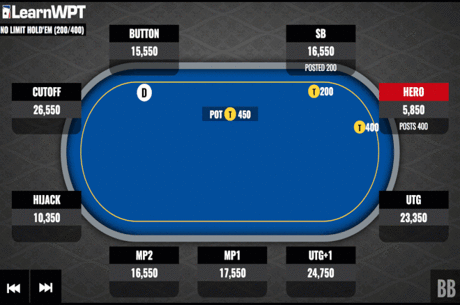Defending Yourself Against the Set Miner

It's one of the worst feelings in poker.
You're playing $2/$5. You've been cruising along picking up some pots. Your starting stack of $500 is now at about $800. You're feeling good about your game and your reads.
You're dealt pocket kings in middle position and raise to the table standard of $20, and only the aggressive player in the cutoff calls. The flop comes Q?7?5? and you lead for $30. Your opponent, who has you covered, raises to $75. Figuring he's likely behind and could raise with a very wide range, you call.
The turn is the 2?. You don't want to give him a free card if he's on a draw by checking your kings, so you bet $150. After a few seconds of what looks like decision-making to you, he calls.
The river is the 2?. Once more, you see it as a very good card for you, missing his likely range and keeping you in the lead. Still you have some doubts. He might have been slow playing you with a set or maybe even a two-pair hand with the deuce. He might have been playing a pair of deuces very unconventionally. Still, you see those possibilities as remote.
You bet $200, not wanting to miss getting him to put in more chips with the better part of his range. Your opponent pauses, then shoves. You figure the pot odds and decide to call, and your opponent flips over 5?5?, leaving you down to the felt.
As noted, it's one of the worst feelings in poker. And it's happened to just about all of us. You were set mined. In this instance, it cost you your stack, and with it the product of a lot of hard work, good play, and good fortune.
Is there a defense against this happening to you?
The simplest answer is, "Of course not, you moron! That's poker. You can't stop your opponent from hitting a set. Next!"
But that flippant response ignores the more important issue. Certainly you can't stop an opponent from hitting a set. But you can diminish the likelihood of it happening while also minimizing the cost of it to you when it does.
Let's be clear up front. Addressing the idea of defense against set mining is a topic not likely to leave you feeling satisfied. No matter what you do or the player you're up against, you can lose your stack to someone hitting a set against you. In other words, there really is no sure-fire defense to protect you against that.
Also worth noting, any change in your approach to hands like this intended to diminish the chance of being set mined can increase your vulnerability to being exploited in other ways by a solid player (as we'll see). Even so, by looking closely at your action during the play of this hand, I think you'll find ways to diminish the chances of being set mined while also limiting the amount you'll lose to the set miner.
Here are some tactics to consider to diminish the negative impact of being set mined.
1. Increase the size of your initial raise to deny your opponent the correct drawing odds.
Your first decision was to raise to $20 in early position with your big pair. Your set-mining adversary surely considered your raise and your stack when deciding what to do. No doubt seeing your very deep stack, he realized that he had the implied odds for the call.
Could you have created a disincentive by raising more? Theoretically, yes. Had you raised the $5 BB to $200, for an extreme example, he would not have had the implied odds for a call. But that sort of defense would be absurd in this situation, with such large stacks.
Even so, with a smaller stack you might consider making your raise slightly larger to discourage set mining. If, for example, you had an effective stack of $200, you might have raised to $30 or $35, making it too expensive for a set miner to call your raise.
Of course the downside is that by raising so much, you also eliminate many lesser hands that might otherwise call you, forcing them to make the right decision of folding when they might otherwise have made the wrong decision of calling for a smaller bet.
2. Play with a shorter stack
A short-stack strategy helps thwart the set miner. As in the explanation above, if your stack is too small, you deprive your opponent of the possibility of winning enough to be worth the long odds of hitting his two-outer.
But this strategy deprives you of the many advantages of a larger stack �� namely outplaying your opponent with well executed aggression and, of course, winning more money when you stack an opponent.
Still, to be sure, in the example above, your astute opponents would have been more likely to have folded their pocket fives to your $35 raise if you only had a $200 stack.
3. Back down from their aggression
You might concede to late-position aggression with your premium pair on the flop, especially when you will be out of position. In our example, you could have folded after your $30 flop bet was raised to $75 from later position.
How often does this happen, after all? Typically, if you are good with table selection, there are few if any players who are prepared to respond to your aggressive action with aggressive action of their own, unless they have a truly superior hand. And so, by conceding in those circumstances when there is return aggression, you deny them the opportunity to make more money against you when you are likely to be dominated.
Safe though that strategy may sound, it has a huge deficiency. While it may make sense against poor players whose betting action is always an indication of the true strength of their hand, against the good players, who include in their range of raising hands some bluffs, your timidity will be exploited. Once they catch on that you back down when raised, you'll be the target of repeated efforts to isolate and then crush you with aggression, hand or no hand. You don't want that.
4. Respond to their aggression with aggression
You might reraise his raise. While this is surely a more expensive option than just folding to his raise, it pays two possible dividends.
First, if he calls or reraises back, you can be fairly certain that he has a set and you save money by check-folding on the turn or river. On the other hand, your reraise might force him to release his hand if he raised you without a set. It's a risky move, as it puts you closer to that point of being pot committed, but it will almost surely slow down your opponents in the future, reducing shot-taking against you and allowing you to fold more correctly when there is aggression in the future.
5. Be more passive in early position
By becoming more passive, you help to disguise your range, making it more difficult (in theory) for your opponent to apply an optimal strategy against you. You are also saving money in the process.
In the example hand above, you would have called preflop in early position with your pair of kings, disguising the strength of your hand in the process. The problem with this passive line would then have been that you would have allowed into the hand many players who might well catch a flop that would put them ahead, diminishing your chances of winning with just your kings.
Two other factors to consider
We all know the importance of considering the image of our opponent when playing against their aggression. If the player is a meek, weak-tight player and they respond very aggressively to your aggression, you should be much more likely to fold to a raise than if you are against a hyper-aggressive maniac.
But if you are to defend your stack effectively against an opponent who hits a set without becoming an easily-exploited weak player yourself, then you've got to also understand your own image as it appears to your opponent.
What image of yourself do you think your recent play at the table has created for others? It's that recent experience that really matters �� not your long-term image �� since nearly all of your opponents will be forming opinions of you based on what they've seen, not what you really are.
Have you folded to a reraise a few times in the last couple of orbits? That spells weak-tight. Have you made some losing calls with less than a premium hand? Maybe you're viewed as a calling station. That image as understood by your opponents will help inform you what their betting action against you may mean.
If you have a weak-tight image, you should be less likely to believe that their reraise on the turn means they hit a set on the flop. If you're viewed as an especially sticky calling station, then you should be more likely to concede to their aggression, as their raise is more likely to mean that they have a truly strong hand.
One other point about being set mined. When all is said and done, I find that most serious players �� including good but not expert players �� tend to give insufficient weight to the possibility that their opponent hit a set on the flop. They concede too seldom and not early enough. They would make more money, in the long run, if they believed that their opponent outdrew them on the flop and if they folded to return fire.
That's because they tend to overestimate the importance of two factors �� their image as a tight player, and the trickiness of their opponents.
The vast majority of players at the intermediate level of $1/$2 and $2/$5 are unlikely to make a raise in the face of strength unless they have a very strong hand. Yes, it happens sometimes �� people do bluff. But it happens far less often than most believe. This may be because of the televised poker that good players see, when such bluffs are shown more frequently. But whatever the reason, I have found that most players in $1/$2 and even in $2/$5 fear being bluffed more than is warranted.
In these games aggression of good players in response to the aggression of other good players is generally a true reflection of their very strong hands. And so it should be respected with a fold more often than it is.
Conclusion
There is no infallible way to stop your opponents from set mining against you. But with the tactics and strategy considerations above, you should be able to diminish the likelihood and the impact of it on your bottom line.
Ashley Adams has been playing poker for 50 years and writing about it since 2000. He is the author of hundreds of articles and two books, Winning 7-Card Stud (Kensington 2003) and Winning No-Limit Hold'em (Lighthouse 2012). He is also the host of poker radio show House of Cards. See www.houseofcardsradio.com for broadcast times, stations, and podcasts.









